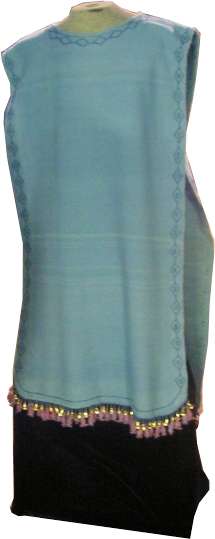Priestly robe (Judaism)
| Part of a series of articles on |
| Priesthood in Judaism |
|---|
| |
|
Kohen · Recognition of priestly descent Priestly covenant |
|
Aaron · Eleazar · Phinehas · Eli · Ahimelech · Abiathar (First Temple) · Zadok · Shallum · Hilkiah · Jehoiada (Second Temple) Joshua the High Priest Simeon the Just Yishmael Ben Elisha Yehoshua ben Gamla Pinchus Ben Shmuel |
|
The ten gifts given in the Temple 1. Sin offering · 2. Guilt offering 3. Communal peace offering 4. Fowl sin offering · 5. Leftovers from the suspensive guilt offering 6. Oil from the offering for the leper 7. Bread from First Fruits · 8. Showbread 9. Leftovers of the meal offering 10. Leftovers of the First Sheaf.
15. Heave offering 16. Heave offering of the Levite's tithe 17. Dough offering 18. First shearing of the sheep 19. Shoulder, cheeks and maw 20. Coins for redemption of the first born son · 21. Redemption of a donkey · 22. Dedication of property to a priest · 23. Field not redeemed in a Jubilee year · 24. The property of the foreigner with no heir. |

The priestly robe (Hebrew me'il מְעִיל ), sometimes robe of the ephod (meil ha-ephod מְעִיל הָאֵפֹוד), is one of the sacred articles of clothing (bigdei kehunah) of the Jewish High Priest. The robe is described in Exodus 28:31-35. It was worn under the Ephod. Like all the priestly garments, it was to be made by 'gifted artisans ... filled with the spirit of wisdom'.[1]
Hebrew Bible
The Hebrew noun meil occurs 30 times in the Masoretic Text of the Hebrew Bible, and refers not only to the robe of the high priest but also any robe worn over a tunic by men of rank, such as the robe Jonathan gave to David, or his mantle which Job tore in desperation, and also the outer cloak of women - such as the robe worn by David's daughters.
It was a sleeveless, purple-blue or violet [2] (techelet) robe (me'il), woven in a single piece. The opening in the center for the High Priest's head to pass through was woven, not cut or torn (Exodus 28:32). The lower hem of the garment was fringed with small golden bells alternating with pomegranate-shaped tassels of blue (turquoise), purple and scarlet wool (Exodus 28:33-34).
The golden bells were a necessity, and they must ring when the High Priest entered the Holy of Holies on the Day of Atonement, lest he die (Exodus 28:35).
Rabbinical commentary
Rashi deduced a law for all the priestly vestments: “From the negative one can derive the positive: if he will have them he will not be liable for death; thus, if he enters lacking one of these garments he is liable for death at the hands of Heaven.”[3] Maimonides rules likewise.[4]
According to the Talmud, the wearing of the priestly robe atoned for the sin of evil speech on the part of the Children of Israel (B.Zevachim 88b).
In traditional Rabbinical teaching, each of the priestly robes is intended to atone for a particular sin on the part of the Children of Israel. The eminent sage Rashi points out in his commentary on the Talmud that the robe was fashioned to atone for the sin of an evil tongue, speaking poorly about someone else. As the High Priest, adorned with the priestly garments, walked, the bells noisily announced his presence, and because the noise emanated from the robe, it served as a reminder for people to refrain from gossip. The Talmud also states that the tassels between each bell on the robe were made of three materials: turquoise, purple, and scarlet wool. These three materials signify to the three people who are injured when lashon hara is spoken: the speaker, the listener, and the one who is spoken about.
See also
- Priestly undergarments
- Priestly tunic
- Priestly sash
- Priestly turban
- Ephod
- Priestly breastplate
- Priestly frontlet
- Tetzaveh parsha, 20th liturgical reading
- Kittel, white robe and burial shroud
References
- ↑ Exodus 28:3 NKJV
- ↑ Hirsch, Emil G.; Levias, Caspar (1905), "Color", Jewish Encyclopedia, IV, New York: Funk and Wagnals, p. 177, retrieved 2008-02-24
- ↑ Rabbi Shlomo Yitzhaqi, Commentary on the Babylonian Talmud, 28:35. Rashi's sources are Sanhedrin 83a and Zevachim 17b.
- ↑ Moses Maimonides, Laws of the Sanctuary Vessels 10:4.
External links
- Shabbat Parshat Tetzaveh description of the Me'il and its spiritual significance
- Me'il Techelet Robe of the Ephod being constructed by The Temple Institute in Jerusalem